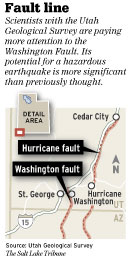
Quake Fears Rise Along S. Utah Fault
Mark Havnes - The Salt Lake Tribune
CEDAR CITY - A St. George snapshot: Stores rise. Homes multiply. Classrooms swell. Traffic backs up. And the earth - shakes.
Perhaps more often than previously thought.
Geologists warn that a fault near St. George may be more active, and thus more dangerous, than experts originally suspected - a worry that is triggering additional research and could crimp development in Utah's booming Dixie.

The subject of the scrutiny: the so-called Washington Fault, which runs north-south through Washington City and parallels the Hurricane Fault several miles to the east.
"Depending on its activity, it could place a lot of things at risk," Bill Lund, senior geologist with the Utah Geological Survey in southern Utah, said Friday from his Cedar City office. "The new data could show it is more of a hazard than we thought."

ORIGINAL CAPTION: Residents of Utah's Dixie could be in for a seismic shock one day, according to the Utah Geologic Survey's recent analysis of the Washington Fault. "If what we suspect is true, that the Washington Fault is more persistently active in recent geologic time than we thought, then the hazard rating level in the area could go up," said Lund, UGS senior scientist and southern Utah regional geologist.
That means more risk to existing structures and more to future ones.
"A lot of development is taking place along the fault, and a lot more will take place if the Lake Powell pipeline is ever built," Lund said. "Our goal is not to scare people, but rather to make sure the earthquake hazard is adequately characterized and that people are aware of the potential hazard."
Experts now will try to determine the frequency and severity of earth movements along the fault.
Depending on those findings, said Dean Cox, emergency-services director for Washington County, government officials may need to update emergency plans and do more to ensure building codes are enforced.
"Earthquakes don't kill people," Cox said. "Falling buildings do."
St. George Public Works Director Larry Bulloch said he had not heard of the new Washington Fault studies, but noted that officials are aware of temblor dangers. He said all bridges in the city are designed to withstand earthquakes.
Barbara Hjelle, an attorney and assistant manager with the Washington County Water Conservancy District, said it was hard for her to comment on what impact the fault could have on existing or planned dams.
"Engineers do complete evaluations before finalizing plans for any reservoir," she said.
New interest in the Washington Fault surfaced last spring, Lund explained, when crews with a consulting company - conducting a geologic study for a new development in Washington City - discovered a rupture a few inches underground.
The rupture's close proximity to the surface indicates the fault's last major activity - a temblor of at least 6.5 magnitude - could have occurred 10,000 years ago.
By comparison, Lund said, a 5.8-magnitude quake along the Hurricane Fault near Zion National Park in 1992 destroyed three homes, wiped out a water tank and damaged the highway to the park.
"That quake wasn't large enough to rupture the surface but did cause a lot of shaking," he said, "and that is what is most damaging."
Lund emphasized that all studies so far are preliminary. Trench samples have been sent to Utah State University for analysis. A final report on the fault is expected in 2008.
"If what we suspect is true," Lund said, "the Washington Fault may eventually be added to . . . national earthquake hazard maps."
And for Cox and other government officials, one of the three catastrophic threats facing their region - fires, floods and earthquakes - will have grown.
http://origin.sltrib.com/news/ci_7782058
http://www.kutv.com/news/local/story.aspx?content_id=56c98792-f346-426a-b96f-b0e7790f2d2d
www.standeyo.com/NEWS/07_Earth_Changes/071223.Utah.EQ.threat.html
